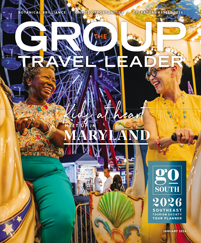We interviewed industry leaders about the challenges and opportunities for the industry as younger travelers continue to increase their group presence.
Carylann Assante, CEO, Student and Youth Travel Association (SYTA)
Terry Dale, President and CEO, United States Tour Operators Association (USTOA)
Catherine Prather, President, NTA
Fred Ferguson, President and CEO, American Bus Association (ABA)
As the unpredictability of the early post-pandemic period fades into the rear view, tourism organizations worldwide have settled into a new equilibrium between high demand and high prices. In 2024, however, political tensions and overtourism issues have created ongoing uncertainty for the travel industry. The Group Travel Leader spoke with the heads of four tourism associations to get their perspectives on the industry’s prospects and challenges for 2025 and beyond.
There’s a growing sense among many people in our industry that the public at large — and especially younger generations — are rediscovering the appeal of group travel. Have you seen indications of that? How is this trend impacting your members?
Prather: The short answer is yes. More and more tour operators are adapting their products to appeal not only to younger travelers, but also to appeal to the changing preference of their typical older travelers, who are just at the top of Generation X. Their new product is active, authentic, connecting with the local communities, culturally rich and supporting small businesses. Many tour operators tell me they are working with clients who are younger — in their mid 40s rather than their mid 50s.
Ferguson: I think the answer is yes. What’s old is new. I have seen reports that classic rock among Gen Z is one of the most-listened-to stations on Spotify. I think group travel, traveling via motorcoach, seems to be really hot right now. It’s a more authentic way to travel, because you’re not spending so much time lugging your bags in these mega-airports. You’re going from Point A to Point B to Point C to Point D way quicker and having more experiences. And at each of those stops, you’re getting more photo captures and more footage for TikTok videos.
Dale: Yes, we are seeing it. The younger generations are recognizing that shared experiences bring another layer to travel that they enjoy, and they find it more impactful and meaningful. My dentist in Manhattan is in his mid-30s. When I asked him where he’s off to next, he said he and his wife had booked a trip with a USTOA member. He said, ‘At the end of the day, we felt that we wanted to do this tour and do it with other people.’ They had an absolutely amazing experience. That speaks volumes to me. Anecdotally, our members recognize it’s there. And this notion of shared experience is going to be a growing market for us.
Assante: I would agree that there the appeal of group travel is growing in the student travel segment of 18-plus travelers. They are more inclined to travel with their peers. They are connected to their community and share information, tips and experiences through technology that really promotes traveling with others. In the younger student travel segment, we are seeing a softening of the group numbers — fewer students traveling per group and more cancellations of entire groups. This is still a reflection of the pandemic, where younger students were home instead of joining the band, playing a sport or engaging in after-school programs, which directly impacts groups of students traveling together.
Is there an affordability crisis growing in travel? Have inflation and demand pressures pushed prices too high for our key demographics? Are they changing the way your members do business?
Dale: I believe that yes, there’s a recognition that prices are high. But the overall value our members are providing the traveler is still greater than the price increase. Is it dampening demand? Post-pandemic, in 2022 and 2023, we saw that spike from pent-up demand. We went into 2024 with members being very optimistic — 92% forecasting an increase in sales from 7% to 10%. We’re also seeing this year level off. So we’re not seeing a dip from rising prices, but a plateau.
Assante: Affordability is definitely an issue in the student group travel segment. We have seen more than a 30% increase in costs from hotels, transportation and meals. Many students fundraise for their school trips and did not anticipate the increase in costs for trips in 2024″“’25. Now, they are adjusting and student groups are still traveling. Overall numbers are higher than in 2019. As for changes in how they plan travel, travel planners and their customers are looking at more affordable destinations, and they are willing to give up a day of their trip to mitigate the costs.
Prather: We are getting close to an affordability situation. We need to ensure travel remains accessible to all and not only the wealthy. That’s a concern for me. NTA tour operators aren’t seeing a slowdown in the demand for travel, but we’re hearing that some destinations may begin to lose market share due to higher prices. The same is true for some types of suppliers. With harsher terms on groups, like when a hotel demands a large nonrefundable deposit or attrition clauses, most operators either charge their clients more or find another property with more flexible terms. And it’s the same with motorcoaches — tour operators understand that driver wages are high. But fuel costs don’t seem that high, and it feels like fuel surcharges are excessive.
Ferguson: So much of group travel completely stopped during COVID. When you look at the baseline of 2020, we have had hockey-stick-shaped growth since then. When we look at data on average passengers per motorcoach, since 2020, it has grown like crazy. Many of our members are small businesses, and there’s no question that inflation has impacted their performance. But at the same time, there’s a lot of demand for our services, and right now we’re benefiting from that demand.
Some high-profile destinations are taking measures to limit visitation and mitigate overtourism. How is that affecting your members? If the trend becomes more widespread, how might it impact travel overall?
Assante: This is a challenge for the student group travel segment, as many parents will pay for the trip with the expectation that their students will see iconic attractions and experience what that destination is famous for. The students have to travel as a group by motorcoach, and many of these destinations are limiting how many coaches may enter their cities. Our members are working more closely with their destination partners to determine off-peak times to travel, shoulder periods, and what other local attractions can accommodate the groups if they cannot all visit one attraction at the same time.
Prather: It is important for tour operators and all travel professionals to protect the destinations and treasured places we visit. And yes, overtourism is a challenge in some places. In North America, it’s a challenge in some of our most popular national parks, or in places like New England in leaf season. Tour operators can help by driving visitation to other places that have a similar vibe to those popular places and by shifting travel to shoulder season. But it takes a destination and local suppliers to help make those changes possible. Help that tour operator look like a hero by giving them that five-star resort at four-star prices if they come in a different season.
Ferguson: I think there’s a lot of value in the motorcoach tour, because the level of education we can present to visitors is much higher than a car full of people would get. Think of a national park, for example. When a motorcoach shows up, our drivers and leaders give people rules of the road — using the correct restroom facilities, not walking off the trail, following rangers’ directions. And a motorcoach showing up at a park gate represents 25 to 30 fewer cars. If we welcome more motorcoaches, we can have a better visitor experience, just from reduced congestion alone. So I think we’re actually a major part of the solution.
Dale: It is currently impacting us. In some communities, they’re restricting access to a motorcoach, which means our members have to adapt and shift to five vans, with eight passengers in a van. For the industry as a whole, I’m seeing a shift from a marketing model to a tourism management model. Of course we want the DMOs to market and tell our story, which helps our sales and generates jobs and tax revenues. But we also have to be sensitive to the pressures from a community when the residents say, ‘enough is enough.’
This year’s elections could bring about significant changes in Washington. What policy issues are you monitoring right now, and what are the potential impacts of political changes on the tourism community?
Ferguson: I’ve been involved in D.C. politics for 16 years now, and I have learned that every election cycle is ‘the craziest.’ That’s the norm. I think the most important thing we can do as an industry is have a clear and concise point of view on our policy agenda. And that transcends who’s in power. One issue in particular is the electric vehicle movement. What I’m finding is that the infrastructure to support larger vehicles electrifying isn’t built out the same way it is for cars. So we need to say, ‘we understand the EV movement, but we need a lot of investment in the infrastructure to support electrification.’
dale: The Department of Transportation and its recent rulemaking when it comes to refunds and ancillary fees is something we address on a weekly basis. We can’t relitigate some of what has been communicated through the rulemaking, so it’s a matter of working with the DOT as a partner to figure out its application and what is reasonable for our members. Another thing we have to do as an industry, whoever gets elected, is to protect the U.S.A. brand. We have to be able to communicate in a credible way that we are a welcoming and inviting country.
Assante: SYTA is working with a coalition of associations, travel industry organizations and government agencies to promote the United States as a destination for student travelers. We have seen a decline in student travel to the U.S. and attendance by international students at our universities. Visas are still an issue for student travelers to the U.S., so we are working with U.S. Travel Association and others to improve wait times and approval of visas. We feel that our students traveling abroad and welcoming incoming students is essential to building empathy and understanding of other cultures.
Prather: I feel most of the issues will be the same, no matter what happens. For example, national parks are one of the biggest areas where we put our focus. For quite some time, we’ve been working with other associations and the U.S. National Park Service on the upcoming launch of the online system of conditional use authorizations to enter the parks. And of course, we’re constantly monitoring visitor visa processing times. We have some great events coming into the U.S. — the 2026 World Cup and the 2028 Summer Olympics. But in some top inbound markets, the U.S. has visa interview wait times of nearly 400 days. That causes significant interruptions.











